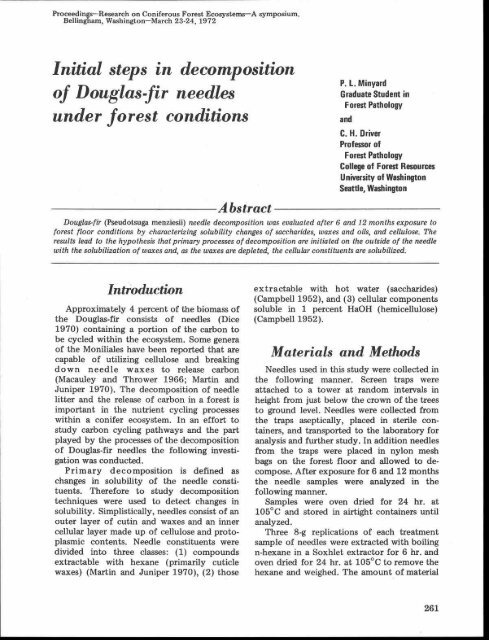PE EIE[R-Rg RESEARCH ON - HJ Andrews Experimental Forest
PE EIE[R-Rg RESEARCH ON - HJ Andrews Experimental Forest
PE EIE[R-Rg RESEARCH ON - HJ Andrews Experimental Forest
You also want an ePaper? Increase the reach of your titles
YUMPU automatically turns print PDFs into web optimized ePapers that Google loves.
Proceedings-Research on Coniferous <strong>Forest</strong> Ecosystems-A symposium .<br />
Bellingham, Washington-March 23-24, 197 2<br />
Initial steps in decomposition<br />
of Douglasfir needles<br />
under forest conditions<br />
Abstract<br />
P. L . Minyar d<br />
Graduate Student i n<br />
<strong>Forest</strong> Pathology<br />
Douglas-fir (Pseudotsuga menziesii) needle decomposition was evaluated after 6 and 12 months exposure t o<br />
forest floor conditions by characterizing solubility changes of saccharides, waxes and oils, and cellulose. Th e<br />
results lead to the hypothesis that primary processes of decomposition are initiated on the outside of the needl e<br />
with the solubilization of waxes and, as the waxes are depleted, the cellular constituents are solubilized.<br />
and<br />
C . H . Drive r<br />
Professor of<br />
<strong>Forest</strong> Pathology<br />
College of <strong>Forest</strong> Resources<br />
University of Washingto n<br />
Seattle, Washingto n<br />
Introduction<br />
Approximately 4 percent of the biomass of<br />
the Douglas-fir consists of needles (Dic e<br />
1970) containing a portion of the carbon to<br />
be cycled within the ecosystem . Some genera<br />
of the Moniliales have been reported that are<br />
capable of utilizing cellulose and breakin g<br />
down needle waxes to release carbo n<br />
(Macauley and Thrower 1966 ; Martin and<br />
Juniper 1970) . The decomposition of needl e<br />
litter and the release of carbon in a forest is<br />
important in the nutrient cycling processe s<br />
within a conifer ecosystem . In an effort to<br />
study carbon cycling pathways and the par t<br />
played by the processes of the decompositio n<br />
of Douglas-fir needles the following investigation<br />
was conducted .<br />
Primary decomposition is defined a s<br />
changes in solubility of the needle constituents.<br />
Therefore to study decompositio n<br />
techniques were used to detect changes i n<br />
solubility . Simplistically, needles consist of an<br />
outer layer of cutin and waxes and an inne r<br />
cellular layer made up of cellulose and protoplasmic<br />
contents. Needle constituents wer e<br />
divided into three classes : (1) compound s<br />
extractable with hexane (primarily cuticl e<br />
waxes) (Martin and Juniper 1970), (2) those<br />
extractable with hot water (saccharides)<br />
(Campbell 1952), and (3) cellular components<br />
soluble in 1 percent HaOH (hemicellulose )<br />
(Campbell 1952) .<br />
Materials and Methods<br />
Needles used in this study were collected i n<br />
the following manner . Screen traps wer e<br />
attached to a tower at random intervals i n<br />
height from just below the crown of the tree s<br />
to ground level . Needles were collected fro m<br />
the traps aseptically, placed in sterile containers,<br />
and transported to the laboratory for<br />
analysis and further study. In addition needle s<br />
from the traps were placed in nylon mes h<br />
bags on the forest floor and allowed to de -<br />
compose. After exposure for 6 and 12 months<br />
the needle samples were analyzed in th e<br />
following manner .<br />
Samples were oven dried for 24 hr . at<br />
105°C and stored in airtight containers unti l<br />
analyzed .<br />
Three 8-g replications of each treatmen t<br />
sample of needles were extracted with boiling<br />
n-hexane in a Soxhlet extractor for 6 hr . and<br />
oven dried for 24 hr. at 105°C to remove the<br />
hexane and weighed . The amount of material<br />
261








